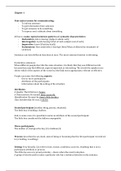Summary
Summary English Sentence Analysis - Marjolijn Verspoor, Kim Sauter
- Course
- Institution
- Book
An extensive summary of all chapters (H1 tm H8) of the book 'English Sentence Analysis' for the course linguistics (taalkunde). With this summary I passed the exam without a resit.
[Show more]




